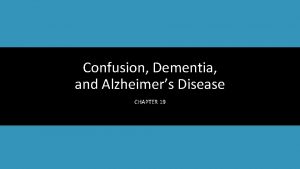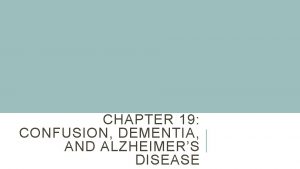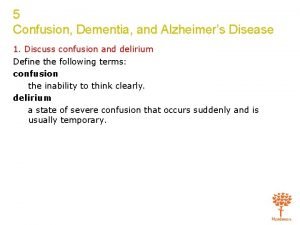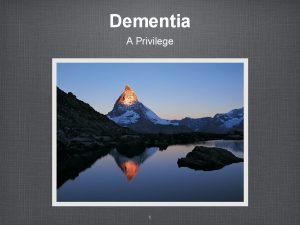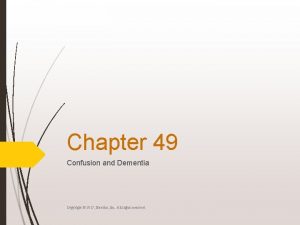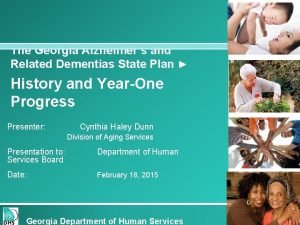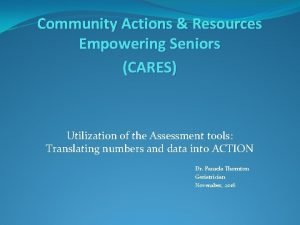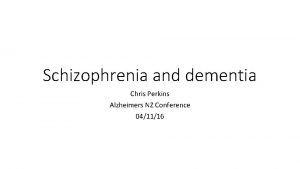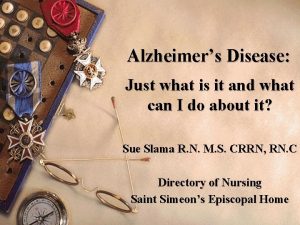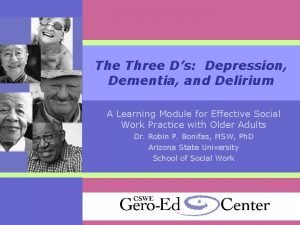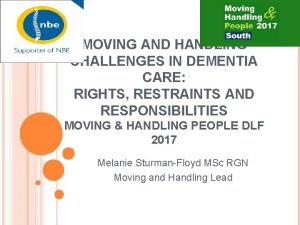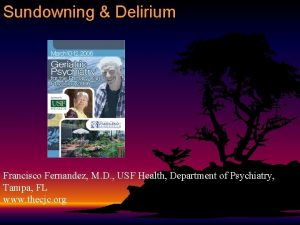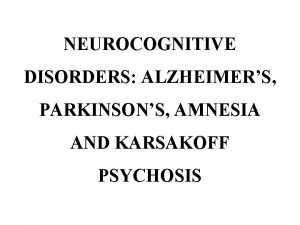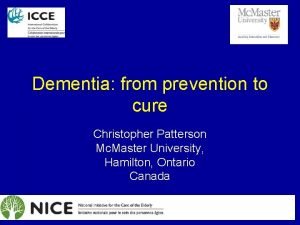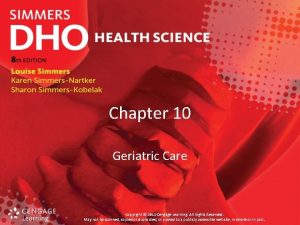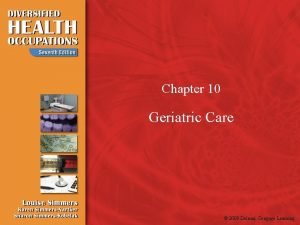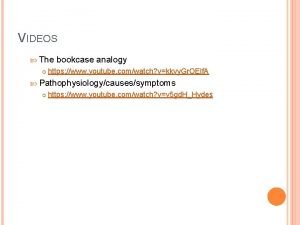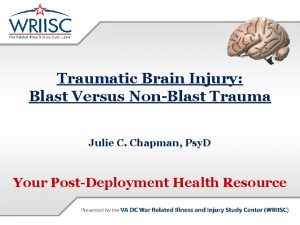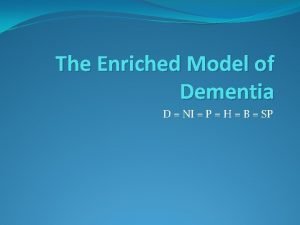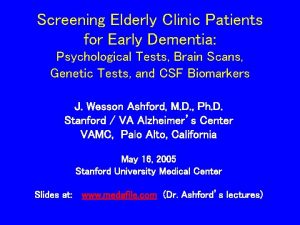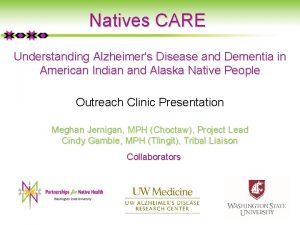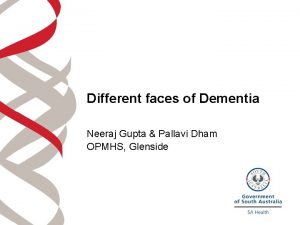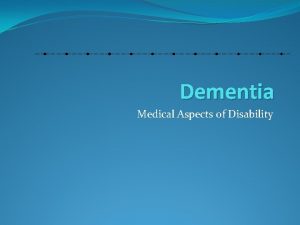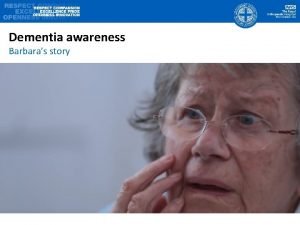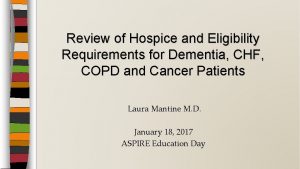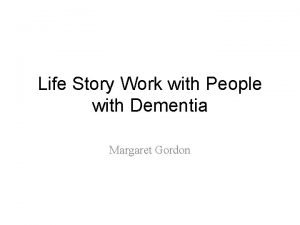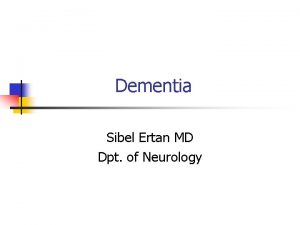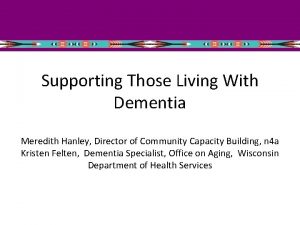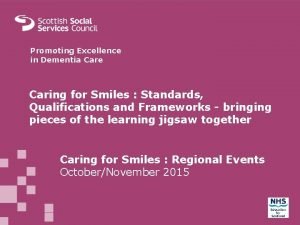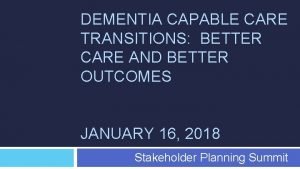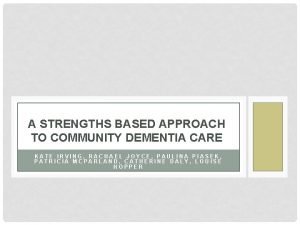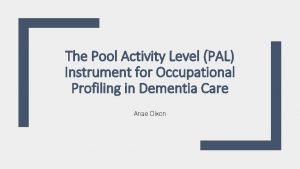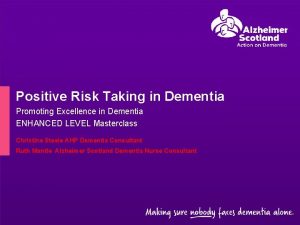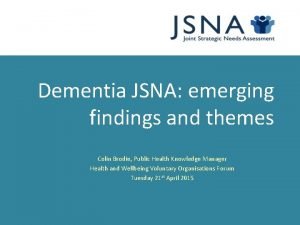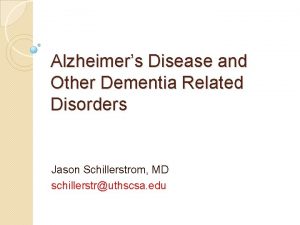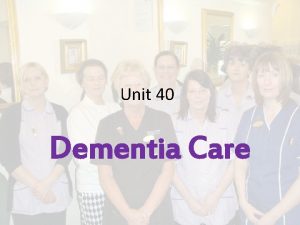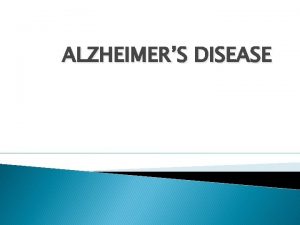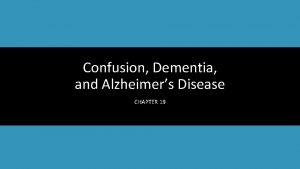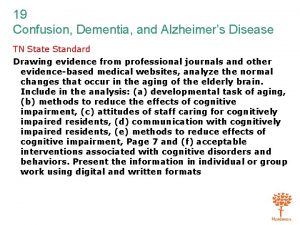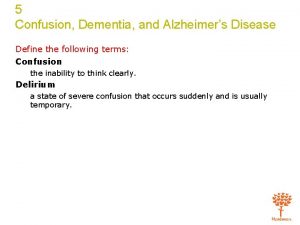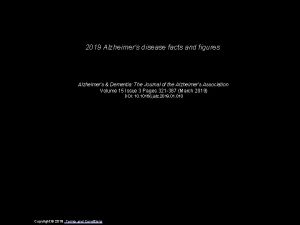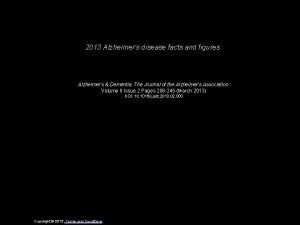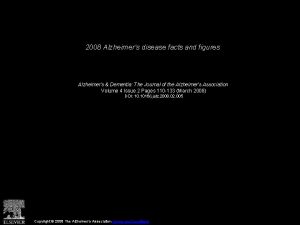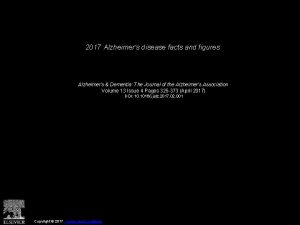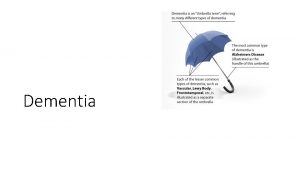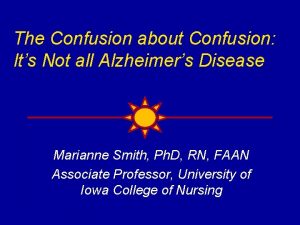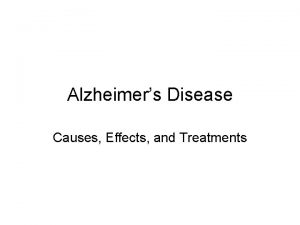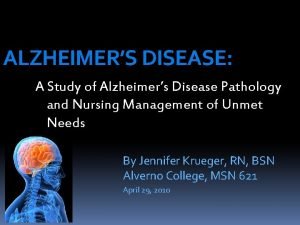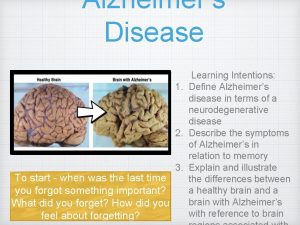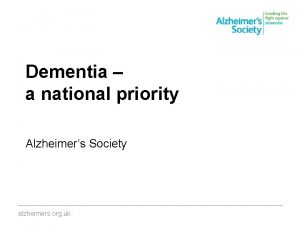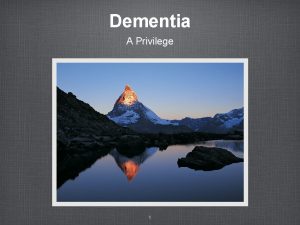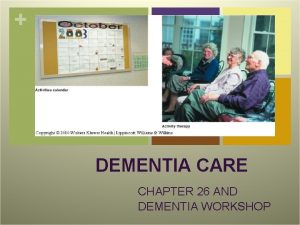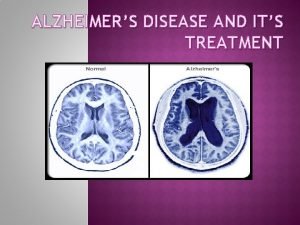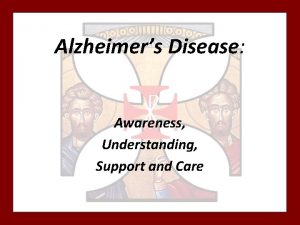5 Confusion Dementia and Alzheimers Disease 1 Discuss
















































- Slides: 48

5 Confusion, Dementia, and Alzheimer’s Disease 1. Discuss confusion and delirium Define the following terms: confusion the inability to think clearly. delirium a state of severe confusion that occurs suddenly and is usually temporary.

5 Confusion, Dementia, and Alzheimer’s Disease 1. Discuss confusion and delirium Remember these points about confusion: • Interferes with ability to make decisions • Personality may change • Anger, depression, and irritability are other signs • Can be temporary or permanent

5 Confusion, Dementia, and Alzheimer’s Disease 1. Discuss confusion and delirium Causes of confusion include the following: • Urinary tract infection (UTI) • Low blood sugar • Head trauma or injury • Dehydration • Nutritional problems • Fever • Sudden drop in body temperature

5 Confusion, Dementia, and Alzheimer’s Disease 1. Discuss confusion and delirium Causes of confusion (cont’d): • Lack of oxygen • Medications • Infections • Brain tumor • Diseases or illness • Loss of sleep • Seizures

5 Confusion, Dementia, and Alzheimer’s Disease 1. Discuss confusion and delirium When caring for a resident with confusion • Do not leave resident alone. • Stay calm. Provide a quiet environment. • Speak in a lower tone of voice. Speak clearly and slowly. • Introduce yourself each time you see resident. • Remind resident of location, name, and date. • Explain what you are going to do using simple instructions. • Do not rush the resident. • Talk about plans for the day. • Encourage the use of eyeglasses and hearing aids. • Promote self-care and independence. • Report observations to the nurse.

5 Confusion, Dementia, and Alzheimer’s Disease 1. Discuss confusion and delirium Causes of delirium include the following: • Infections • Disease • Fluid imbalance • Poor nutrition • Drugs • Alcohol

5 Confusion, Dementia, and Alzheimer’s Disease 1. Discuss confusion and delirium These are all symptoms of delirium: • Agitation • Anger • Depression • Irritability • Disorientation • Trouble focusing • Problems with speech • Changes in sensation and perception • Changes in consciousness • Decrease in short-term memory

5 Confusion, Dementia, and Alzheimer’s Disease 1. Discuss confusion and delirium REMEMBER: It helps to be gentle and to keep one’s voice low when communicating with someone who is confused or disoriented. Use the person’s name and speak clearly, using simple sentences. Reduce distractions as much as possible.

5 Confusion, Dementia, and Alzheimer’s Disease 2. Describe dementia and discuss Alzheimer’s disease Define the following terms: cognition the ability to think logically and clearly. cognitive impairment loss of ability to think logically; concentration and memory are affected. dementia the serious loss of mental abilities, such as thinking, remembering, reasoning, and communicating. Alzheimer’s disease a progressive, incurable disease that causes tangled nerve fibers and protein deposits to form in the brain, eventually causing dementia.

5 Confusion, Dementia, and Alzheimer’s Disease 2. Describe dementia and discuss Alzheimer’s disease REMEMBER: Dementia is not a normal part of aging.

5 Confusion, Dementia, and Alzheimer’s Disease 2. Describe dementia and discuss Alzheimer’s disease The following are common causes of dementia: • Alzheimer’s disease • Multi-infarct or vascular dementia (a series of strokes causing damage to the brain) • Lewy Body disease • Parkinson’s disease • Huntington’s disease

5 Confusion, Dementia, and Alzheimer’s Disease 2. Describe dementia and discuss Alzheimer’s disease Diagnosing dementia is a complicated process: • Involves getting a patient’s medical history and having a physical and neurological exam. • Blood tests and imaging tests like CT or MRI scans may be ordered. • Tests to trace brain wave activity (EEG) may be performed. • Diagnosis of dementia helps rule out other possible diseases with similar symptoms.

5 Confusion, Dementia, and Alzheimer’s Disease Transparency 5 -1: Facts about Alzheimer’s Disease • Alzheimer’s disease is the most common cause of dementia in the elderly. • As many as 5. 2 million people in the U. S. are living with Alzheimer’s disease. • Women are more likely than men to have AD. • Risk increases with age, but it is not a normal part of aging. • AD is progressive, degenerative, and irreversible. • Tangled nerve fibers and protein deposits in brain cause dementia. • Cause is currently unknown and diagnosis is difficult. • Length of time from onset to death can range from three to 20 years. • Each person will show different signs at different times.

5 Confusion, Dementia, and Alzheimer’s Disease 2. Describe dementia and discuss Alzheimer’s disease NAs should remember these points when caring for residents with AD: • Every person with Alzheimer’s progresses differently, showing different symptoms at different times. • AD residents should be encouraged to do self-care and keep their minds and bodies active for as long as possible.

5 Confusion, Dementia, and Alzheimer’s Disease Transparency 5 -2: Helpful Attitudes for Working with AD Residents • • Do not take things personally. Be empathetic. Work with symptoms and behaviors noted. Work as a team. Be aware of the difficulties associated with caregiving. Work with family members. Remember the goals of the care plan.

5 Confusion, Dementia, and Alzheimer’s Disease 3. List strategies for better communication with residents with Alzheimer’s disease Define the following term: perseveration the repetition of words, phrases, questions, or actions.

5 Confusion, Dementia, and Alzheimer’s Disease 3. List strategies for better communication with residents with Alzheimer’s disease When communicating with a resident with AD • Approach from the front. • Determine how close the resident wants you to be. • Communicate in a room with little background noise and distraction. • Always identify yourself. Use the resident’s name. • Speak slowly, using a lower tone of voice. • Repeat yourself, using the same words and phrases, as often as needed. • Use signs, pictures, gestures, or written words to help communicate. • Break complex tasks into smaller, simpler ones.

5 Confusion, Dementia, and Alzheimer’s Disease 3. List strategies for better communication with residents with Alzheimer’s disease If a resident with Alzheimer’s disease is frightened or anxious • Keep him calm. • Speak in a low, calm voice. Get rid of noise and distractions. • Try to see and hear yourself as residents might. Describe what you are going to do. • Use simple words and short sentences. • Check your body language.

5 Confusion, Dementia, and Alzheimer’s Disease 3. List strategies for better communication with residents with Alzheimer’s disease If a resident with Alzheimer’s disease forgets or shows memory loss • Repeat yourself using the same words. If a resident does not understand a word, try a different one. If resident perseverates, answer questions using the same words each time. • Keep messages simple. Break complex tasks into smaller, simpler ones.

5 Confusion, Dementia, and Alzheimer’s Disease 3. List strategies for better communication with residents with Alzheimer’s disease If a resident with Alzheimer’s disease has trouble finding words or names • Suggest a word that sounds correct. • Try not to correct a resident who uses an incorrect word.

5 Confusion, Dementia, and Alzheimer’s Disease 3. List strategies for better communication with residents with Alzheimer’s disease If a resident with Alzheimer’s disease seems not to understand basic instructions or questions • Ask resident to repeat your words. Use short words and sentences. Allow time to answer. • Use the communication methods that are effective. • Watch for nonverbal cues. Observe body language. • Use signs, pictures, gestures, or written words.

5 Confusion, Dementia, and Alzheimer’s Disease 3. List strategies for better communication with residents with Alzheimer’s disease If a resident with Alzheimer’s disease wants to say something but cannot • Encourage resident to point, gesture, or act it out. • Offer comfort with a smile if resident is upset.

5 Confusion, Dementia, and Alzheimer’s Disease 3. List strategies for better communication with residents with Alzheimer’s disease If a resident with Alzheimer’s disease does not remember how to perform basic tasks • Break each activity into simple steps.

5 Confusion, Dementia, and Alzheimer’s Disease 3. List strategies for better communication with residents with Alzheimer’s disease If a resident with Alzheimer’s disease insists on doing something that is unsafe or not allowed • Limit the times you say “Don’t. ” • Redirect activities instead.

5 Confusion, Dementia, and Alzheimer’s Disease 3. List strategies for better communication with residents with Alzheimer’s disease If a resident with Alzheimer’s disease hallucinates or is paranoid or accusing • Do not take it personally. • Try to redirect behavior or ignore it.

5 Confusion, Dementia, and Alzheimer’s Disease 3. List strategies for better communication with residents with Alzheimer’s disease If a resident with Alzheimer’s disease is depressed or lonely • Take time one-on-one to ask how he is feeling. Listen to the response. • Try to involve the resident in activities. • Report depression to the nurse.

5 Confusion, Dementia, and Alzheimer’s Disease 3. List strategies for better communication with residents with Alzheimer’s disease If a resident with Alzheimer’s disease repeatedly asks to “go home” • Ask the resident to tell her what his home was like and how he felt being there. • Redirect to something he enjoys. • Expect questions to continue, and remain patient and gentle with responses.

5 Confusion, Dementia, and Alzheimer’s Disease 3. List strategies for better communication with residents with Alzheimer’s disease If a resident with Alzheimer’s disease is verbally abusive or uses bad language • Remember it is the dementia speaking and not the person. Try to ignore the language. • Redirect attention.

5 Confusion, Dementia, and Alzheimer’s Disease 3. List strategies for better communication with residents with Alzheimer’s disease If a resident with Alzheimer’s disease has lost most verbal skills • Remember it is the dementia speaking and not the person. Try to ignore the language. • Redirect attention.

5 Confusion, Dementia, and Alzheimer’s Disease 4. List and describe interventions for problems with common activities of daily living (ADLs) NAs working with residents with AD should remember these three general principles for providing care: • Develop a routine and stick to it. • Promote self-care. • Take good care of yourself, both mentally and physically.

5 Confusion, Dementia, and Alzheimer’s Disease Handout 5 -1: Interventions for ADLs Bathing • Schedule bathing when resident is least agitated. • Give resident supplies before bathing to serve as visual aid. • Take a walk with resident down the hall and stop at tub or shower room. • Make sure bathroom is well-lit and at a comfortable temperature. • Provide privacy. • Be calm and quiet. Keep process simple. • Be sensitive when discussing bathing with resident. • Give resident washcloth to hold during bath. • Ensure safety by using nonslip mats, tub seats, and hand-holds. • Be flexible about when to bathe. Understand if resident does not want to bathe. • Be relaxed. Offer encouragement and praise.

5 Confusion, Dementia, and Alzheimer’s Disease Handout 5 -1: Interventions for ADLs (cont’d) • Let the resident do as much as possible during bath. • Check the skin for signs of irritation. Grooming and Dressing • Help with grooming. • Avoid delays or interruptions. • Show resident clothing to put on. • Provide privacy. • Encourage resident to pick out clothes to wear. Lay out clothes in the order in which they will be put on. • Break task down into simple steps. Do not rush the resident. • Use a friendly, calm voice when speaking. Praise and encourage.

5 Confusion, Dementia, and Alzheimer’s Disease Handout 5 -1: Interventions for ADLs (cont’d) Toileting • Encourage fluids, even if resident has problems with urinary incontinence. • Mark bathroom with sign or picture. • Make sure there is enough light, both in the bathroom and on the way there. • Note when resident is incontinent. Check him or her every 30 minutes. Take resident to bathroom before bathroom time. • Observe toilet patterns for two to three nights if resident is incontinent during night. • Take resident to bathroom after drinking fluids. Make sure resident urinates before getting off toilet. • Take resident to bathroom before and after meals and before bed. • Put lids on trash cans, wastebaskets, or other containers if resident urinates in them.

5 Confusion, Dementia, and Alzheimer’s Disease Handout 5 -1: Interventions for ADLs (cont’d) Nutrition • Be professional when cleaning after episodes of incontinence. • Have meals at consistent times each day. Serve familiar foods. Food should look and smell appetizing. • Make sure there is adequate lighting. • Keep noise and distractions to a minimum. • Keep the task of eating simple. Finger foods are easier to eat. • Do not serve steaming or very hot foods or drinks. • Use plain plates without a pattern or color. Use a simple place setting. Remove other items from the table. • Put only one item of food on plate at a time. • Give simple, clear instructions on how to eat or use utensils. • Place a spoon to the lips. • Ask resident to open his or her mouth. • Guide resident through meal with simple instructions. Offer regular drinks to avoid dehydration.

5 Confusion, Dementia, and Alzheimer’s Disease Handout 5 -1: Interventions for ADLs (cont’d) • Use adaptive equipment as needed. • Feed resident slowly, giving small pieces of food. • Make mealtimes simple and relaxed. Give resident time to swallow each bite. • Seat residents with others to encourage socializing. • Observe for eating and swallowing problems. Observe and report changes or problems.

5 Confusion, Dementia, and Alzheimer’s Disease Handout 5 -1: Interventions for ADLs (cont’d) Additional tips • Prevent infections. Follow Standard Precautions. • Observe and report potential problems. • Give careful skin care. • Watch for signs of pain. • Maintain daily exercise routine. • Maintain self-esteem. Encourage independence. • Share in enjoyable activities. • Reward positive and independent behavior with smiles, hugs, and warm touches.

5 Confusion, Dementia, and Alzheimer’s Disease 5. List and describe interventions for common difficult behaviors related to Alzheimer’s disease Define the following terms: sundowning becoming restless and agitated in the late afternoon, evening, or night. catastrophic reaction reacting to something in an unreasonable, exaggerated way. pacing walking back and forth in the same area.

5 Confusion, Dementia, and Alzheimer’s Disease 5. List and describe interventions for common difficult behaviors related to Alzheimer’s disease Define the following terms: wandering walking aimlessly around the facility or facility grounds. elope in medicine, when a person with Alzheimer’s disease wanders away from a protected area and does not return. hallucinations seeing, hearing, smelling, tasting, or feeling things that are not there.

5 Confusion, Dementia, and Alzheimer’s Disease 5. List and describe interventions for common difficult behaviors related to Alzheimer’s disease Define the following terms: delusions false beliefs. pillaging taking things that belong to someone else. hoarding collecting and putting things away in a guarded way.

5 Confusion, Dementia, and Alzheimer’s Disease Handout 5 -2: Difficult Behaviors and Management Agitation Remove triggers, keep routine, focus on familiar activity, remain calm, and soothe. Sundowning Remove triggers, avoid stress, play soft music, set bedtime routine, plan calming activity, remove caffeine, give back massage, distract, and encourage daily exercise. Catastrophic Reactions Avoid triggers such as fatigue, changes, overstimulation, difficult choices/tasks, pain, hunger, or need for toileting. Remove triggers and distract. Violent Behavior Block blows, never hit back, step out of reach, call for help, do not leave resident alone, remove triggers, and use calming techniques.

5 Confusion, Dementia, and Alzheimer’s Disease Handout 5 -2: Difficult Behaviors and Management (cont’d) Pacing and Wandering Remove causes, give snacks, encourage exercise, maintain toileting schedule, let resident pace in safe place, and suggest another activity. Hallucinations or Delusions Ignore if harmless, reassure, do not argue, and stay calm. Depression Report signs, encourage independence, talk about moods and feelings, and encourage social interaction. Perseveration or Repetitive Phrasing Respond with patience, do not stop behavior, and answer questions each time, using the same words.

5 Confusion, Dementia, and Alzheimer’s Disease Handout 5 -2: Difficult Behaviors and Management (cont’d) Disruptiveness Gain resident’s attention, be calm, direct to a private area, ask about behavior, notice and praise improvements, tell resident about changes, encourage to join in activities, help find ways to cope, and focus on positive activities. Inappropriate Social Behavior Do not take it personally, stay calm, reassure, find out cause, direct to private area, respond positively to appropriate behavior, and report abuse to nurse. Inappropriate Sexual Behavior Be sensitive, distract, direct to private area, and consider other ways to provide physical stimulation.

5 Confusion, Dementia, and Alzheimer’s Disease Handout 5 -2: Difficult Behaviors and Management (cont’d) Sleep Disturbances Make sure resident gets moderate exercise or activity during the day. Allow resident to spend time in natural sunlight if possible. Reduce light and noise during nighttime hours. Discourage sleeping during the day. Pillaging and Hoarding Label belongings, place a label or symbol on door, do not tell others that person is stealing, prepare the family, ask family to report unfamiliar items, and provide a rummage drawer.

5 Confusion, Dementia, and Alzheimer’s Disease 5. List and describe interventions for common difficult behaviors related to Alzheimer’s disease REMEMBER: Residents with AD may try to elope, or leave a facility unsupervised and unnoticed. If a resident with AD elopes the NA must inform the nurse right away. The earlier a search is begun, the more likely the resident is to be found nearby and safe.

5 Confusion, Dementia, and Alzheimer’s Disease 5. List and describe interventions for common difficult behaviors related to Alzheimer’s disease REMEMBER: People with AD may be at a higher risk for abuse. One reason for this is that caring for someone with AD is very demanding, physically and psychologically. NAs should take good care of themselves to ensure they are able to provide the best possible care.

5 Confusion, Dementia, and Alzheimer’s Disease 6. Describe creative therapies for residents with Alzheimer’s disease Define the following term: validating giving value to or approving.

5 Confusion, Dementia, and Alzheimer’s Disease 6. Describe creative therapies for residents with Alzheimer’s disease Four creative therapies may be useful in working with residents with Alzheimer’s disease: • Reality orientation uses clocks, calendars, signs and lists to help residents remember who and where they are. • Validation therapy allows residents to believe they live in the past or in imaginary circumstances. • Reminiscence therapy encourages residents to remember and talk about the past. • Activity therapy uses activities that the resident enjoys to prevent boredom and frustration and to promote self-esteem.

5 Confusion, Dementia, and Alzheimer’s Disease 6. Describe creative therapies for residents with Alzheimer’s disease Think about these questions: At which stages of Alzheimer’s disease might each of these therapies be useful? What are the benefits of these therapies?
 Confusion dementia and alzheimer disease chapter 19
Confusion dementia and alzheimer disease chapter 19 Confusion dementia and alzheimer disease chapter 19
Confusion dementia and alzheimer disease chapter 19 Confusion dementia and alzheimer's disease
Confusion dementia and alzheimer's disease Chapter 19 confusion dementia and alzheimer's disease
Chapter 19 confusion dementia and alzheimer's disease Alzheimers society contented dementia
Alzheimers society contented dementia Chapter 49 confusion and dementia
Chapter 49 confusion and dementia Amateurs discuss tactics professionals discuss logistics
Amateurs discuss tactics professionals discuss logistics Communicable disease and non communicable disease
Communicable disease and non communicable disease Georgia alzheimers planning
Georgia alzheimers planning Fast score dementia
Fast score dementia Vaskulär demens
Vaskulär demens Alzheimers nz conference 2020
Alzheimers nz conference 2020 Site:slidetodoc.com
Site:slidetodoc.com Alzheimer's eye test joke
Alzheimer's eye test joke Positive physical approach
Positive physical approach Difference between dementia and delirium
Difference between dementia and delirium Wendylett sheets 1 carer
Wendylett sheets 1 carer Francisco fernandez md
Francisco fernandez md Types of amnesia
Types of amnesia Dementia treatments and interventions near patterson
Dementia treatments and interventions near patterson Confusion and diffusion in cryptography
Confusion and diffusion in cryptography Diffusion and confusion in cryptography
Diffusion and confusion in cryptography Chapter 10:5 meeting the needs of the elderly
Chapter 10:5 meeting the needs of the elderly Chapter 10:4 confusion and disorientation in the elderly
Chapter 10:4 confusion and disorientation in the elderly Dementia bookcase analogy
Dementia bookcase analogy Dementia pugilistica
Dementia pugilistica Enriched model of dementia care
Enriched model of dementia care Latragenic
Latragenic Dementia 2015
Dementia 2015 Tom kitwood enriched model of dementia care
Tom kitwood enriched model of dementia care Reversible dementia
Reversible dementia Reversible dementia
Reversible dementia Barbara's story dementia
Barbara's story dementia Risk factor dementia
Risk factor dementia Hospice lcd dementia
Hospice lcd dementia Life story work dementia
Life story work dementia Trasodone
Trasodone Meredith hanley
Meredith hanley Promoting excellence in dementia care
Promoting excellence in dementia care Rarly signs of dementia
Rarly signs of dementia Dementia capable care
Dementia capable care Crescare
Crescare Dementia pool activity level
Dementia pool activity level Symptoms of dementia
Symptoms of dementia Positive risk-taking dementia
Positive risk-taking dementia Receptive language
Receptive language Dementia
Dementia Frontotemporal dementia
Frontotemporal dementia Unit 40 health and social care
Unit 40 health and social care
